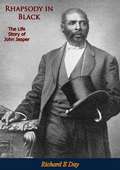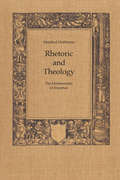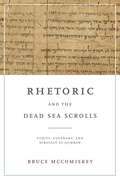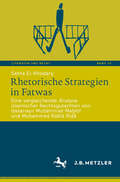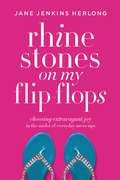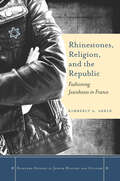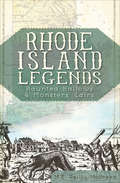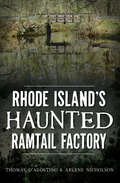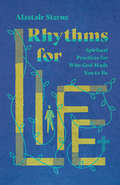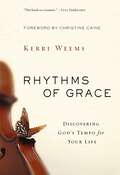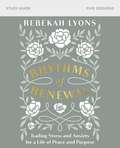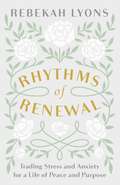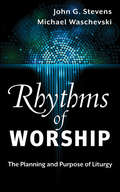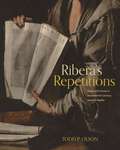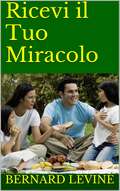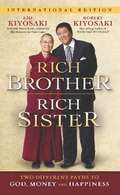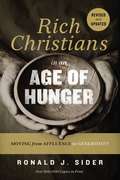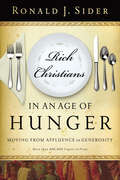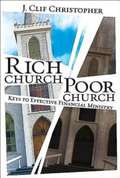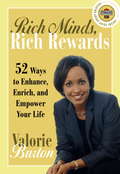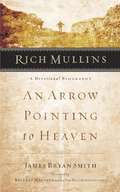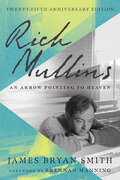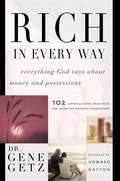- Table View
- List View
Rhapsody in Black: The Life Story of John Jasper
by Richard E Day“The life and ministry of John Jasper – the extraordinary preacher of the 19th-century South, who labored not for civil rights or political activism, but for Christ. Crowds of all races gathered to hear this slave preach!Jasper began to preach the gospel as a slave in Virginia. About half of his preaching career was as a slave and half was as a free man. He had no formal education or seminary training, but was legendary in his time. He often drew large crowds to his meetings of both the black and white race. Governors, judges, legislators, and “learned” white ministers were greatly moved by the power of Jasper’s preaching.The Sixth Mount Zion Church in Richmond, Virginia stands to this day as a memorial to John Jasper, and nearby is his grave which is marked by a splendid monument.”—Grace and Truth Books
Rhetoric and Theology: The Hermeneutic of Erasmus (The Royal Society of Canada Special Publications)
by Manfred HoffmanDeparting from the traditional focus on Erasmus as philologist and moralist, Rhetoric and Theology shows how Erasmus attempted to interpret Scripture by way of a rhetorical theology that focuses on the figurative, metaphorical quality of language, with a view to moral and theological reform. Manfred Hoffmann concentrates on the theological scources of Erasmus' hermeneutic from 1518 to 1535, especially the Ratio verae theologiae, the Ecclesiastes, and the exegesis of Old and New Testament texts. He shows that Erasmus' hermeneutic is based on the concept of language as mediation. Words do not have the power to represent the truth unambiguously, but they appeal to our understanding in ways that draw us to the truth through the process of interpretation. For Erasmus it is through allegory that the divine Word carries out its mediation between letter and spirit.Erasmus used the tools of rhetoric to read and understand Scripture, and thereby constructed a theological framework that has a direct relationship with his hermeneutic. Rhetorical theologians imitate the invention, disposition, inverbation, and delivery of divine speech by clarifying its composition, ordering its subject matter, internalizing its content, and communicating its transforming power of persuasion. Rhetoric provided Erasmus with the tools for finding theological loci in Scripture, drawing from it a repertoire for knowing and living, and translating it into sacred oratory.
Rhetoric and the Dead Sea Scrolls: Purity, Covenant, and Strategy at Qumran
by Bruce McComiskeyDiscovered in 1947, the Dead Sea Scrolls are a collection of ancient Israelite documents, many of which were written by a Jewish sectarian community at Qumran living in self-exile from the priesthood of the Second Temple. This first book-length study of the rhetoric of these texts illustrates how the Essenes employed different rhetorics over time as they struggled to understand God’s word and their mission to their people, who seemed to have turned away from God and his purposes.Applying methods of rhetorical analysis to six substantive texts—Miqṣat Maʿaśeh ha-Torah, Rule of the Community, Damascus Document, Purification Rules, Temple Scroll, and Habakkuk Pesher—Bruce McComiskey traces the Essenes’ use of rhetorical strategies based on identification, dissociation, entitlement, and interpretation. Through his analysis, McComiskey uncovers a unique, fascinating story of an ancient religious community that had sought to reintegrate into Temple life but, dejected, instead established itself as the new covenant people of God for this world, only to turn ultimately to a trust in a metaphysical afterlife.Presenting forms of ancient Jewish rhetoric largely uninfluenced by classical rhetoric, this book broadens our understanding of human and religious rhetorical practice, even as it provides new insight into the events that led to the emergence of the Talmudic period. Rhetoric and the Dead Sea Scrolls will be useful to scholars working in the fields of religious rhetoric, Jewish studies, and early Christianity.
Rhetoric and the Dead Sea Scrolls: Purity, Covenant, and Strategy at Qumran
by Bruce McComiskeyDiscovered in 1947, the Dead Sea Scrolls are a collection of ancient Israelite documents, many of which were written by a Jewish sectarian community at Qumran living in self-exile from the priesthood of the Second Temple. This first book-length study of the rhetoric of these texts illustrates how the Essenes employed different rhetorics over time as they struggled to understand God’s word and their mission to their people, who seemed to have turned away from God and his purposes.Applying methods of rhetorical analysis to six substantive texts—Miqṣat Maʿaśeh ha-Torah, Rule of the Community, Damascus Document, Purification Rules, Temple Scroll, and Habakkuk Pesher—Bruce McComiskey traces the Essenes’ use of rhetorical strategies based on identification, dissociation, entitlement, and interpretation. Through his analysis, McComiskey uncovers a unique, fascinating story of an ancient religious community that had sought to reintegrate into Temple life but, dejected, instead established itself as the new covenant people of God for this world, only to turn ultimately to a trust in a metaphysical afterlife.Presenting forms of ancient Jewish rhetoric largely uninfluenced by classical rhetoric, this book broadens our understanding of human and religious rhetorical practice, even as it provides new insight into the events that led to the emergence of the Talmudic period. Rhetoric and the Dead Sea Scrolls will be useful to scholars working in the fields of religious rhetoric, Jewish studies, and early Christianity.
Rhetorische Strategien in Fatwas: Eine vergleichende Analyse islamischer Rechtsgutachten von Ḥasanayn Muḥammad Maḫlūf und Muḥammad Rašīd Riḍā (Literatur und Recht #14)
by Sehra El-KhodaryDieses Buch untersucht, wie islamische Rechtsgelehrte im 20. Jahrhundert in ihren Rechtsgutachten (Fatwas) rhetorisch Autorität generieren und wie sich Traditionalismus und Reformdenken in den Argumentationsmustern, der Intertextualität sowie im Duktus dieser Texte niederschlagen. Damit bietet dieses Buch einen interdisziplinären Zugang zu islamischen Rechtstexten, deren sprachliche Realisierung bisher nur wenig Aufmerksamkeit erhalten hat. Dies, obwohl eine Auseinandersetzung mit der Rhetorik rechtlicher Praxis vertiefte Einblicke in diese sowie in die Konstitutionsbedingungen der Rechtstexte verspricht, ausgehend von dem Grundgedanken der „Recht und Literatur“-Forschung, dass Recht schließlich immer über Sprache kommuniziert wird. Der erste Teil des Buches bietet einen umfassenden Überblick über die Genese des breit gefächerten Genres der Fatwa und des Muftitums bis zur Moderne, wobei Ägypten im Fokus steht. Anschließend werden zwei exemplarisch ausgewählte Fatwas zur Thematik Fotografie/Bildwerke des Reformers Muḥammad Rašīd Riḍā (1865–1935) und des Traditionalisten Ḥasanayn Muḥammad Maḫlūf (1890–1990) im Lichte sowohl gesellschaftlicher Umbrüche des frühen 20. Jahrhunderts als auch des andauernden innerislamischen Diskurses um taqlīd und iǧtihād, ein Diskurs um Geltung, Kompetenz und Autorität, auf mehreren Ebenen detailliert analysiert.
Rhinestones on My Flip-Flops: How To Make Life Choices That Sparkle And Shine
by Jane Jenkins HerlongRHINESTONES ON MY FLIP FLOPS offers the message Jane lives by: prove people wrong and laugh while living your dreams.Has your life ever flipped? The challenge is to not become a flop! Strap on your sandals and let RHINESTONES ON MY FLIP-FLOPS deliver joy and laughter in the midst of everyday mess-ups.Professional Southern humorist and award-winning author Jane Jenkins Herlong uses humor, wisdom, and life stories from iconic biblical women to guide you through the inevitable blunders of life. Learn from the flip-flops of Deceived Eve, Domestic Diva Martha and Whiny Naomi. Laugh and be inspired by honest (ouch) stories delivered with Jane's sparkling sense of humor. Add in some "rhinestoned" advice from modern Women of Wisdom (WOW). And you will learn how to keep the sparkle and shine on your God-given talents even as you experience life's inevitable flops! p.p1 {margin: 0.0px 0.0px 0.0px 0.0px; font: 12.0px Geneva} p.p2 {margin: 0.0px 0.0px 0.0px 0.0px; text-indent: 36.0px; font: 12.0px Geneva}
Rhinestones, Religion, and the Republic: Fashioning Jewishness in France
by Kimberly A. ArkinDuring the course of her fieldwork in Paris, anthropologist Kimberly Arkin heard what she thought was a surprising admission. A French-born, North African Jewish (Sephardi) teenage girl laughingly told Arkin she was a racist. When asked what she meant by that, the girl responded, "It means I hate Arabs. " This girl was not unique. She and other Sephardi youth in Paris insisted, again and again, that they were not French, though born in France, and that they could not imagine their Jewish future in France. Fueled by her candid and compelling informants, Arkin's analysis delves into the connections and disjunctures between Jews and Muslims, religion and secular Republicanism, race and national community, and identity and culture in post-colonial France. "Rhinestones" argues that Sephardi youth, as both "Arabs" and "Jews," fall between categories of class, religion, and culture. Many reacted to this liminality by going beyond religion and culture to categorize their Jewishness as race, distinguishing Sephardi Jews from "Arab" Muslims, regardless of similarities they shared, while linking them to "European" Jews (Ashkenazim), regardless of their differences. But while racializing Jewishness might have made Sephardi Frenchness possible, it produced the opposite result: it re-grounded national community in religion-as-race, thereby making pluri-religious community appear threatening. "Rhinestones" thus sheds light on the production of race, alienation, and intolerance within marginalized French and European populations.
Rhode Island Legends: Haunted Hallows & Monsters' Lairs (American Legends Ser.)
by M. E. Reilly-McGreenA historical tour of the Ocean State&’s spookiest sites, with photos included! Rhode Island&’s ghostly heritage is as deep and profound as the history of the state itself. From the ghastly moaning bones of Mount Tom to the stately haunt of Judge Potter in a local library, Rhode Island&’s apparitions have been causing fear for centuries. Follow M.E. Reilly-McGreen as she reveals the ghoulish stories of the state&’s most haunted places. The author delves deep to unearth both little-known tales and those that have helped define the state&’s supernatural history. From ghosts to monsters, this book is your guide to all things spooky in Rhode Island.
Rhode Island's Haunted Ramtail Factory (Haunted America Ser.)
by Thomas D'Agostino Arlene NicholsonOfficially listed as haunted by the Rhode Island Census, this dilapidated Foster factory gives up its secrets to New England&’s resident ghost experts. On May 19, 1822, Peleg Walker was found dead inside Foster&’s Ramtail Factory. Almost ten years earlier, he and four other family members had made the fateful decision to start a business. Legend has it that when relations soured over arguments about money, the partnership ended, with Peleg hanging from the very bell rope he rang each morning to signal the change in shift. Whether he took his own life or was murdered remains a mystery. Recognized as a haunted site since 1885, the factory now lies in ruins. Yet Peleg still keeps vigil over its remains, sounding his night watchman&’s bell and drifting with his candle lantern in hand. Authors Tom D&’Agostino and Arlene Nicholson share over two decades of research into the mysterious history of Rhode Island&’s haunted factory. Includes photos! &“Over the past twenty-five years, D&’Agostino has explored scores of sites and produced several books on his adventures, including Haunted Rhode Island. When snooping for spooks, he and his wife, Arlene, carry a briefcase of high-tech gadgetry to document his findings.&” —Rhode Island Monthly
Rhythms for Life: Spiritual Practices for Who God Made You to Be
by Alastair SterneWho are you becoming? And how will you get there? Spiritual transformation is not a one-size-fits-all journey. Each of us has a particular identity, gifts, values, roles, and purpose. Thus we each need distinct spiritual rhythms that are designed to help us live out that vocation and calling. In this practical book Alastair Sterne shows how we can craft a life of more intentionality, becoming Christlike in ways that fit who we are. First we discover who God made us to be, in all our distinctiveness. Then we enter into spiritual practices that flow out of that particular sense of identity, with fourfold rhythms that point us upward to God, inward to self, withward in community, and outward in mission. Our vocation is our identity uniquely lived out before God, bringing our being and doing together. You can live a life that is more aligned with who you are meant to be. Discover spiritual rhythms that move at the pace of grace, and align you with your unique identity and calling in Christ.
Rhythms of Grace: Discovering God’s Tempo for Your Life
by Kerri Weems Christine CaineLife is not a sprint; it’s a marathon. These well-known words of wisdom remind us to pace ourselves in the journey of life so we reach the finish line with no regrets. Pacing yourself is not as easy as it sounds. Life tends to take on a pace of its own which when left unchecked, will drive us toward burnout and fatigue. We can easily become driven by care, worry, and ambition rather than led by the Holy Spirit. We may tend to think of burnout as a modern problem, but we can see that people in Jesus’ day felt their own kind of spiritual and emotional fatigue. Why else would Jesus have said these comforting words? Are you tired? Worn out? Burned out on religion? Come to me. Get away with me and you’ll recover your life. I’ll show you how to take a real rest. Walk with me and work with me—watch how I do it. Learn the unforced rhythms of grace. I won’t lay anything heavy or ill-fitting on you. Keep company with me and you’ll learn to live freely and lightly (Matt. 11:28-30; The Message). Even though he spoke these words more than two millennia ago, Jesus’ call to rest and peace seem tailor-made to fit this generation. Author Kerri Weems had let the pace and rhythm of her life get out of control. At first the consequences were only physical, but they quickly impacted her spiritual life. Since then, God has been teaching her to walk in time with him; he is teaching her to be led rather than driven. In this book, she opens up her life and shares this journey with the reader. God’s best for each of us is that we go the full distance of our race, and not just crawl exhausted across the finish line. God wants us to enjoy the race and cross the line with our heads held high, a smile on our faces, and our arms lifted in a double fist-punch! Getting to that moment is all about learning the rhythms of grace and pacing ourselves for the long run.
Rhythms of Grace: How the Church's Worship Tells the Story of the Gospel
by Mike CosperIs it singing? A church service? All of life? Helping Christians think more theologically about the nature of true worship, Rhythms of Grace shows how the gospel is all about worship and worship is all about the gospel. Mike Cosper ultimately answers the question: What is worship?
Rhythms of Renewal Bible Study Guide: Trading Stress and Anxiety for a Life of Peace and Purpose
by Rebekah LyonsDaily struggles with anxiety and stress make it difficult to receive God's peace. Trade your anxiety for the vibrant life you were meant to live through four profound rhythms: rest, restore, connect, and create.The Rhythms of Renewal video study (DVD/video streaming sold separately) is your guide to daily rescue and a way forward into the peace your soul longs for.As a society, we are in the throes of a collective panic attack. Anxiety and loneliness are on the rise, with 77% of our population experiencing physical symptoms of stress on a regular basis. We feel pressure chasing careers, security, and keeping up. We worry about health, politics, and many other complexities we can't control. Eventually we find our minds spinning, trying to cope or manage a low hum of anxiety, unlike ever before.But it doesn't have to stay this way.Rebekah Lyons draws from her own battle with depression and anxiety and shares a pathway to establish four life-giving rhythms that quiet inner chaos and make room for a flourishing life. By taking time to rest, restore, connect, and create, you will discover how to:Take charge of your emotional health and inspire your loved ones to do the same.Overcome anxiety by establishing daily habits that keep you mentally and physically strong.Find joy through restored relationships with your family and community.Walk in confidence with the unique gifts you have to offer the world.With encouraging stories and practical steps to take action today, Rebekah will help you begin an intentional, lifelong journey toward sustained emotional, relational, and spiritual health.Designed for use with the Rhythms of Renewal Video Study available on DVD or streaming video, sold separately.
Rhythms of Renewal: Trading Stress and Anxiety for a Life of Peace and Purpose
by Rebekah LyonsDaily struggles with anxiety and stress make it difficult to receive God's peace. Rhythms of Renewal will help you trade your anxiety for the vibrant life you were meant to live through four profound rhythms: rest, restore, connect, and create. With encouraging stories and practical steps, Rebekah Lyons will help you begin an intentional, lifelong journey toward sustained emotional, relational, and spiritual health.Rhythms of Renewal is your guide to daily rescue and a way forward into the peace your soul longs for. As a society, we are in the throes of a collective panic attack. Anxiety and loneliness are on the rise, with 77% of our population experiencing physical symptoms of stress on a regular basis. We feel pressure chasing careers, security, and keeping up. We worry about health, politics, and many other complexities we can't control. Eventually we find our minds spinning, trying to cope or manage a low hum of anxiety, unlike ever before. But it doesn't have to stay this way. Rebekah draws from her own battle with depression and anxiety and shares a pathway to establish four life-giving rhythms that quiet inner chaos and make room for a flourishing life. By taking time to rest, restore, connect, and create, you will discover how to: Take charge of your emotional health and inspire your loved ones to do the sameOvercome anxiety by establishing daily habits that keep you mentally and physically strongFind joy through restored relationships in your family and communityWalk in confidence with the unique gifts you have to offer the world
Rhythms of Worship: The Planning and Purpose of Liturgy
by John G. Stevens Michael WaschevskiThere are many books written for liturgical experts, but not many for laypeople. This book bridges that gap. In clear, everyday language, Waschevski and Stevens describe why Protestants worship and help to equip worship planners and leaders for excellence in their tasks. The authors explore the different elements of the worship service and how each expresses our Christ-centered faith. They also describe the feasts and festivals of the liturgical year, helping the reader understand and appreciate these special times and seasons in worship. An additional chapter considers music and arts in worship. Discussion questions at the end of each chapter invite discussion in local congregations. This book will be a valuable resource for pastors, worship committees, members, and all others who engage in worship planning and leadership.
Ribera’s Repetitions: Paper and Canvas in Seventeenth-Century Spanish Naples
by Todd P. OlsonThe seventeenth-century Valencian artist Jusepe de Ribera spent most of his career in Spanish Viceregal Naples, where he was known as “Lo Spagnoletto,” or “the Little Spaniard.” Working under the patronage of Spanish viceroys, Ribera held a special position bridging two worlds. In Ribera’s Repetitions, art historian Todd P. Olson sheds new light on the complexity of Ribera’s artwork and artistic methods and their connections to the Spanish imperial project.Drawing from a diverse range of sources, including poetry, literature, natural history, philosophy, and political history, Olson presents Ribera’s work in a broad context. He examines how Ribera’s techniques, including rotation, material decay (through etching), and repetition, influenced the artist’s drawings and paintings. Many of Ribera’s works featured scenes of physical suffering—from Saint Jerome’s corroded skin and the flayed bodies of Saint Bartholomew and Marsyas to the ragged beggar-philosophers and the eviscerated Tityus. But far from being the result of an individual sadistic predilection, Olson argues, Ribera’s art was inflected by the legacies of the Reconquest of Spain and Neapolitan coloniality. Ribera’s material processes and themes were not hermetically sealed in the studio; rather, they were engaged in the global Spanish Empire.Pathbreaking and deeply interdisciplinary, this copiously illustrated book offers art history students and scholars a means to see Ribera’s art anew.
Ricevi il Tuo Miracolo
by Bernard Levine Valeria BraganteDescrizione del libro: Questo libro è un libro emozionante che vi renderà molto felici quando comincerete a scoprire i segreti della vita, della felicità e del successo. Siate sinceri con voi stessi e seguite il vostro cuore. Lasciate che i miracoli che desiderate, inizino ad apparire nella vostra vita!
Rich Brother, Rich Sister: Two Different Paths to God, Money and Happiness
by Robert T. Kiyosaki Emi KiyosakiTogether, then apart, then together again, as a brother and a sister discover the riches of life. Rich Brother Rich Sister combines the inspirational, true life stories of Robert Kiyosaki and his sister Emi Kiyosaki (Venerable Tenzin Kacho) into a book that will reaffirm your belief in the power of purpose, the importance of action, and the ability to overcome obstacles in a quest for a rich life. In 1962, the United States detonated an atomic bomb ten miles off the coast of Christmas Island in the South Pacific. From that moment, two people, born of the same parents into the same household with the same childhood experiences, found themselves on distinctly different paths toward God, money, and happiness. Robert became a world-famous entrepreneur, author, and teacher of all things financial. Emi became a highly devout Buddhist nun, author, and teacher of all things spiritual. Their lives took them from the Big Island of Hawaii to Cam Ranh Bay in Vietnam, to the hippie communes in Haight-Ashbury and to a monastery in India, to private encounters with Dr. R. Buckminster Fuller, to a seat at the foot of His Holiness the Dalai Lama, and ultimately back together again. Robert faced death in war, and Emi faced it in the form of cancer. They took risks, made mistakes, learned life's lessons, and found their own truths. They discovered the peace, the happiness, and the wealth that come through living the lives they were meant to live, the way they were meant to live them. This book will inspire you along your own life's journey as you search for your own truths, purpose, and path to wealth - both financial and spiritual - to achieve all the riches of life that were meant for you. . . and for us all.
Rich Christians in an Age of Hunger
by Ronald J. SiderDo you want to make a true difference in the world? Dr. Ron Sider does. He has, since before he first published Rich Christians in an Age of Hunger in 1978. Despite a dramatic reduction in world hunger since then, 34,000 children still die daily of starvation and preventable disease, and 1.3 billion people, worldwide, remain in abject poverty. So, the professor of theology went back to re-examine the issues by twenty-first century standards. Finding that Conservatives blame morally reprehensible individual choices, and Liberals blame constrictive social and economic policy, Dr. Sider finds himself agreeing with both sides. In this new look at an age-old problem, he offers not only a detailed explanation of the causes, but also a comprehensive series of practical solutions, in the hopes that Christians like him will choose to make a difference.
Rich Christians in an Age of Hunger: Moving from Affluence to Generosity (Fifth Edition)
by Ronald SiderDo you want to make a true difference in the world? Dr. Ron Sider does. He has, since before he first published Rich Christians in an Age of Hunger in 1978. Despite a dramatic reduction in world hunger since then, 34,000 children still die daily of starvation and preventable disease, and 1.3 billion people, worldwide, remain in abject poverty. So, the professor of theology went back to re-examine the issues by twenty-first century standards. Finding that Conservatives blame morally reprehensible individual choices, and Liberals blame constrictive social and economic policy, Dr. Sider finds himself agreeing with both sides. In this new look at an age-old problem, he offers not only a detailed explanation of the causes, but also a comprehensive series of practical solutions, in the hopes that Christians like him will choose to make a difference.
Rich Church, Poor Church: Keys to Effective Financial Ministry
by J. Clif ChristopherDoes your church have the necessary funds to do ministry?In Dr. Clif Christopher's nearly forty years in ministry as a pastor and President of Horizons Stewardship Company, he has witnessed the financial stewardship practices of thousands of churches. A few have exceptional records in acquiring and managing the necessary funds for mission and ministry, but the vast majority struggle every year to get by.In this important new work made even more relevant by our economic times, Christopher contrasts the traits of the most productive congregations with those who perennially fail to secure the funds to perform transformational ministry. Some churches practice the necessary financial habits that form the foundation of successful ministry, and others waste valuable resources and undermine ministry opportunities.Through Christopher’s insight born out of years of experience and consultation, readers can assess the financial condition of their own churches.
Rich Minds, Rich Rewards
by Valorie BurtonA rich mind nourished with positive thoughts, learning, and encouragement can indeed reap rich rewards, writes dynamic author Valorie Burton as she offers 52 simple but powerful ways to enrich your everyday life and do those things that will bring you the rewards you so richly deserve, such as: • Count Your Blessings • Change Your Ways to Change Your Life • Create a Vision Statement • Mind Your Own Business • Create Your Own Opportunities • Listen to Your Inner Voice
Rich Mullins: An Arrow Pointing to Heaven
by James Bryan SmithDuring his life, Rich Mullins challenged the sensibilities of what it means to follow Jesus in today's world, and now in his death, he challenges all to build upon his legacy of joy, compassion, brokenness, unblinking honesty, and wonder of an Awesome God.
Rich Mullins: An Arrow Pointing to Heaven
by James Bryan SmithExperience Rich Mullins's Legacy of Joy and Real CompassionBeloved contemporary Christian musician Rich Mullins lived his life with abandon for God, leaving the spotlight to teach music among a Navajo community. An accident cut his life short in 1997, but his songs and ragamuffin spirit continue to teach many.Rich Mullins: An Arrow Pointing to HeavenSee the layers of his story through reflections from friends and family, an afterword by Rich's brother David Mullins, and Smith's own bond with him. And in remembrance, be inspired to enjoy God's world as Rich did.
Rich in Every Way
by Gene GetzOur relationship to our possessions -- few topics are more timely for today's blessed Christians . . . or more neglected. Yet author Gene Getz tells readers that the Bible says more about the things we own than any other subject except the Godhead. His thorough exploration of biblical history reveals overarching "supraprinciples" of ownership that apply to all people everywhere, then and now. Getz shows how Christians can resist the deadly tendency towards selfishness inherent in today's culture and how to use their possessions as effective tools for witness and spiritual growth. Avoiding both the extreme of "selling all and giving to the poor" and the greed-centered "prosperity gospel," he explains the biblical attitude toward possessions: a releasing of "this is mine" view of our possessions and allowing God's gifts to flow through our hands to meet human needs, demonstrating His love to an unbelieving world.
